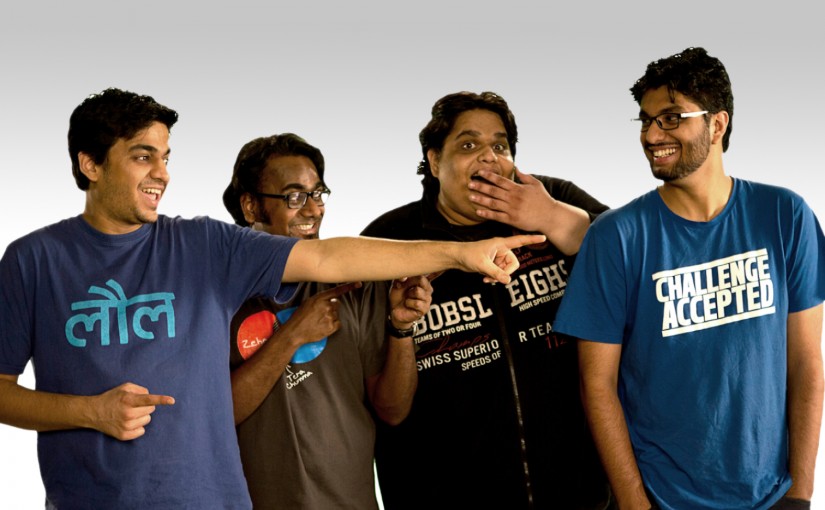Drop us a few lines about the task and we will get back immediately to see we how we can take the discussion forward. Alternately, just pick up the phone and speak with us at +91 9910034330 and we would be happy to help.
- - Do tell us a little about the nature of your business.
- - Be specific about what you’d like us to help you with.
- - Knowing your budget always helps us plan a suitable intervention.
- Blog
My Interview in ‘Career 360’ Magazine
-
My Interview in ‘Career 360’ Magazine
A couple of weeks back, Career 360, a magazine focused on careers (from the Outlook Group) had reached out for a story on Careers in Social Media Marketing. Their September issue has carried the feature and includes a short interview of mine on the opportunities in Social Media space.
Here are excerpts from the story
DELHI lad Clinton Jeff starts his day with Gmail, followed by postings on Twitter and Facebook, a couple of breaks for lunch and coffee, with a hard day’s work ending on Flickr, YouTube and his personal blog. Keeping up with a few close friends, several hundred followers and several more readers can be quite exhausting, but doing it as part of his company’s business strategy is a totally different scenario.
But hey, he’s not complaining. After all, working extensively on these social media websites is earning Clinton, Head of Strategy, Blogger’s Mind, a social media agency, is his monthly pay packet!
What is social media?
The consensus is that social media refers to any online portal, community, technology or software application that is deployed or created to disseminate, manage, organise, share and reuse content – both textual and graphic. Sanjay Mehta, Joint CEO of Social Wavelength, a Mumbai-based social media agency, explains, “We use social media for multiple functional objectives such as product launch, idea generation, online reputation management, driving sales to online store, and to create a community around a brand.”
Why do firms want a stake here?
“Social media is relevant to any company whose audiences participate in or are influenced by online discussions,” says Jeremy Woolf, the Global Social Media Practice Lead for Text 100, a PR consultancy based in New York, with offices across the globe, including India.Corporate houses such as Wipro, Hindustan Unilever, Infosys and Maruti – are catching up with their western counterparts in terms of investing in this new channel. Star Network, the group of channels comprising Star Plus, Star One, Channel V and so on, has hired Social Wavelength to build its social media presence. Bloggers’ Mind created the hugely popular “Search for N” campaign for the Nokia N97 cellular phone and the “Tag Your Music” Facebook activity for Nokia India’s Music Page. Bloggers’ Mind is a ‘Word of Mouth’ and ‘Conversation Analytics’ company – basically, it helps companies to read, understand and analyse conversations taking place online on their products.
Sandip Maiti, CEO of Experience Commerce, the Mumbai-based digital agency behind the Cedia campaign adds, “It is important to understand the context in which the brand wishes to engage with its core audience. Some brands like to entertain, some like to seed conversation spaces while many prefer to take the utlitarian track. Social media is best used to build awareness and create buzz around new product launches.”
Then you also have unconventional entities like Bollywood stars, cricketers, chefs, new age spiritual gurus, artists, musicians and entrepreneurs making a splash on social media to connect to fans, release tidbits of information on their work, upload photos and respond to audience curiosity, instantly. Even organisations like NGOs, schools and colleges, public institutions, museums and art galleries, trade associations and informal society groups, are on social media, which is typically, viewed as a low-investment, high return of interest tool by those who cannot afford advertising rates of a tabloid or television to garner support for their causes.
Targeting new audience
Mid-sized book publisher Tulika Books caters to a new section of their audience – the Facebook generation. Malarvizhi Jayant, Online Editor of Web & Social Media for Tulika, says, “We announce new books, continue discussions about older publications, discuss issues of literacy and reading, share news, collect reviews of Tulika’s books. The goal is to tell more people about Tulika, the kind of books we publish, and have a communication channel open to fans.”
Bangalore-based Pratham Books, a not-for-profit trust is a children’s book publisher and has championed its cause using social media tools – Facebook, Twitter, Blogger, Scribd, YouTube, and Flickr – quite effectively. Gautam John, the 31-year-old incharge of New Projects at the organisation, says, “Our long term vision is to build a platform to engage our community to co-create and do so much more to contribute to the cause of a book in every child’s hand using a legal framework that allows for a participatory culture.”
Even news producing media such as newspapers, radio, television and now digital TV, and online broadcasting media are tuning in to social media to ramp up circulation, disseminate news, involve readers through promotional activities such as games, contests and interactive quizzes, and constantly provide breaking news.
“Twitter is currently perfect for what we do as a media company — offer readers the hottest tabloid stories as they break across the country — and is, as such, our core media platform. We also use Facebook and Orkut to engage with readers better, and allocate resources for social media marketing, using social news websites like Digg and Stumbleupon,” says Lindsay Pereira, Editor, Mid Day Online.
What is the job?
Mehta identifies two distinct domains of work: promotions and monitoring. “We use social media to create brand awareness or brand building, generate sales leads, product launch, re-launch or re-branding awareness, creating a community around a brand, driving traffic to client website,” he says. Monitoring is about understanding the customers’ perception about the brand, seeking hitherto unknown insights that people have, about the brand online reputation management, identifying influencers in the space for the brand and detecting a PR crisis before it snowballs.
At the entry level, the role of a social media executive includes:
- Assisting in planning and leading the management and implementation of strategic social media programmes
- Participating and initiating conversations across different channels.
- Consuming, creating and sharing relevant content with internal and external communities
- Monitoring and analysing conversations, social media activities and sharing the impact through reviews and reports
- Observing and assimilating trends in social media, tools, technology and applications and appropriately apply that knowledge in on-going/future campaigns.
In a nutshell, the entry level profile is (someone with one or two year’s experience in a communications field) either a role in social media monitoring, involving the “listening in” of conversations, interpreting and bracketing the same. Or a client operations role, where the person manages social media profiles for a client, of course, under supervision from a senior. Mehta explains.
“We have designer/developers – who are there to develop applications; we have social media addicts – who are there to keep tabs on the developments that take place within the industry; marketing guys are also required provided they understand the online and communication media,” says Abhinav Sahai, Co-fonder of Zapylacz.
Who can get the job
“An analytical bent is very important. When we hire for our company, we look for people who understand social media as a tool, much more than just connecting with friends,” says Sahai. The average social media executive in his team is a good communicator, he says. People are NOT from traditional advertising/marketing/PR background, though two to three of his team member may have such a background.
“Most people come from different backgrounds. Sometimes being from advertising/PR/marketing means a lot of legacy knowledge and experience, which has to be first UNLEARNED, before they learn social media. Which is why, we do not really look to hire from traditional advertising and PR backgrounds,” says Mehta. Since social media as an industry has just emerged a year-and-a-half ago, it would not be fair to ask for experience currently, so aptitude counts the most.
Qualifications at entry levels
Education-wise, it helps to have a communication background such as Mass Communication or English Literature. But this is not critical.
“We have Engineers and Arts graduates also, but who are all fundamentally good communicators. On an average, there is one level of the team which has one-two year’s experience, another level that has two-five years experience, and then a few manager level folks, who have five-eight years experience,” concludes Mehta. One can be fundamentally good at language and communication, without being a Mass Communication graduate.
What is important is to have a fundamental feel for repartee, being able to feel the position of a brand in the marketplace, being able to empathise from a consumer’s point of view, and create conversations on behalf of the brand, with that perspective.
“At the beginner level, we look at postgraduates in marketing communication with work experience or training in advertising, PR, online marketing or similar fields. At the same time, we are open to people from diverse backgrounds since certain verticals are best serviced by specialists in that niche,” says Amita Malhotra, Knowledge Manager at Blogworks.
Salaries are high but what is the catch?
As the table alongside shows, salaries range from about Rs. 2 lakhs per annum and raise exponentially to about Rs. 8 – 12 lakhs as one moves up the ladder. But the most important thing to know for anyone looking for a career in this space is that using social media professionally is a completely different ball game from personal use. Given the ease with using many of these tools, many aspirants do not anticipate the issues that need to be taken care of when managing presence for a third party.
A background in marketing and brand communication helps the individual to get the basics right, however, most social media enthusiasts are self-driven and get a better understanding of the space through self-learning and application of the latest tools and technologies. In the coming years, companies are going to be looking for people to manage their social media campaigns/presence and opportunities are going to arise not just on the agency side but clients directly, concludes Malhotra.
Career growth
For a social media agency professional, alternative career options could be to work for a brand as their internal social media head, or in other media careers that will embrace social media soon, as extensions of their current media avatars. Interesting designations are cropping up. ‘Audience Acquisition’ is one such profile. Profiles like Interactive Marketing Specialist, Social Media Marketing Manager, Emerging Media and Content Manager, Social Networking and Communities Manager, Social Media Evangelists, Social Media Addicts have popped up and will be considered quite the norm in the future.
The roles and designations vary right from the executive straight up to the VP levels. So people with little to abundance of experience are all in demand. Just to give an example, last week Hewlett-Packard, HP-India posted a vacancy where the role was to just look at their Twitter and Facebook profiles. With this form of media growing, you will see more such innovative vacancies.
Nidhi Makhija of Experience Commerce says, “The industry is so new and many opportunities lie undiscovered. There’s vast scope to grow either into a digital planner or as a business development executive. These are just stepping stones into higher positions – Account Directors and VPs of Business Development.”
“I would caution graduates to do a thorough background search on the company’s reputation and as the next step, initiate a dialogue with another fresher who has just joined a social media company to gain insights into his daily tasks and role,” says Abhinav.
Also, in social media, the definition of marketing has changed from ‘selling’ to ‘engaging’. So, hard core marketing guys are a strict no-no for the the community, is Abhinav’s parting shot.
Rishi Seth of Text 100, too, shares this opinion.
“As social media is both highly-dynamic and fast-evolving, it is entirely possible that social media will emerge as a satisfying and rewarding career niche under the umbrella of marketing and communications in the long run,” he adds. Text 100’s Woolf sums it up succinctly when talking about the staying power of social media, “Social media exists because it meets a human need to create, collaborate and share.”
My interview: ‘Mid-Level Speedster- Why is it important?’
Q: How do you decide what platforms to use for a client?
A: It is important to first understand the ‘need’ of the customer: what is the business/marketing objective? Platforms as blogs and forums are used by people when they seek information for a purchase while Facebook and Twitter are effective for building engagement. Therefore, the choice of these platforms really depends on what are we trying to achieve.
Q: Any recent, successful social media strategies?
A: One of my favourite short-term campaigns was the ‘Samsung Corby Color Wars’ contest on Twitter in 2009. It was successful in creating a buzz and generating conversations around Samsung Corby in the launch phase and helped the brand take a strong position in the youth and touch phone segment.
Q: Have social media campaigns impacted business margins?
A: A lot of the research resides with marketers who took their early steps in social media and have seen positive impact and therefore increased the share of their social media budgets as against other traditional channels.
Q: How has your educational background and previous work experience contributed to your career?
A: My background and previous work experience in communications has given me a better perspective on how social media is disruptive compared to any previous forms of marketing communication and yet, how in many ways, it helps achieve the same outcomes – brand building, lead generation, customer service etc using different means.
You can read the full story here.
A couple of weeks back, Career 360, a magazine focused on careers from the Outlook stable had reached out for a story on Careers in Social Media Marketing. Their September issue carries the feature and has a short interview of mine on the opportunities in Social Media space.
Here is the full story –DELHI lad Clinton Jeff starts his day with Gmail, followed by postings on Twitter and Facebook, a couple of breaks for lunch and coffee, with a hard day’s work ending on Flickr, YouTube and his personal blog. Keeping up with a few close friends, several hundred followers and several more readers can be quite exhausting, but doing it as part of his company’s business strategy is a totally different scenario.
But hey, he’s not complaining. After all, working extensively on these social media websites is earning Clinton, Head of Strategy, Blogger’s Mind, a social media agency, is his monthly pay packet!
What is social media?
The consensus is that social media refers to any online portal, community, technology or software application that is deployed or created to disseminate, manage, organise, share and reuse content – both textual and graphic. Sanjay Mehta, Joint CEO of Social Wavelength, a Mumbai-based social media agency, explains, “We use social media for multiple functional objectives such as product launch, idea generation, online reputation management, driving sales to online store, and to create a community around a brand.”
Why do firms want a stake here?
“Social media is relevant to any company whose audiences participate in or are influenced by online discussions,” says Jeremy Woolf, the Global Social Media Practice Lead for Text 100, a PR consultancy based in New York, with offices across the globe, including India.
Corporate houses such as Wipro, Hindustan Unilever, Infosys and Maruti – are catching up with their western counterparts in terms of investing in this new channel. Star Network, the group of channels comprising Star Plus, Star One, Channel V and so on, has hired Social Wavelength to build its social media presence. Bloggers’ Mind created the hugely popular “Search for N” campaign for the Nokia N97 cellular phone and the “Tag Your Music” Facebook activity for Nokia India’s Music Page. Bloggers’ Mind is a ‘Word of Mouth’ and ‘Conversation Analytics’ company – basically, it helps companies to read, understand and analyse conversations taking place online on their products.Sandip Maiti, CEO of Experience Commerce, the Mumbai-based digital agency behind the Cedia campaign adds, “It is important to understand the context in which the brand wishes to engage with its core audience. Some brands like to entertain, some like to seed conversation spaces while many prefer to take the utlitarian track. Social media is best used to build awareness and create buzz around new product launches.”
Then you also have unconventional entities like Bollywood stars, cricketers, chefs, new age spiritual gurus, artists, musicians and entrepreneurs making a splash on social media to connect to fans, release tidbits of information on their work, upload photos and respond to audience curiosity, instantly. Even organisations like NGOs, schools and colleges, public institutions, museums and art galleries, trade associations and informal society groups, are on social media, which is typically, viewed as a low-investment, high return of interest tool by those who cannot afford advertising rates of a tabloid or television to garner support for their causes.
Targeting new audience
Mid-sized book publisher Tulika Books caters to a new section of their audience – the Facebook generation. Malarvizhi Jayant, Online Editor of Web & Social Media for Tulika, says, “We announce new books, continue discussions about older publications, discuss issues of literacy and reading, share news, collect reviews of Tulika’s books. The goal is to tell more people about Tulika, the kind of books we publish, and have a communication channel open to fans.”Bangalore-based Pratham Books, a not-for-profit trust is a children’s book publisher and has championed its cause using social media tools – Facebook, Twitter, Blogger, Scribd, YouTube, and Flickr – quite effectively. Gautam John, the 31-year-old incharge of New Projects at the organisation, says, “Our long term vision is to build a platform to engage our community to co-create and do so much more to contribute to the cause of a book in every child’s hand using a legal framework that allows for a participatory culture.”
Even news producing media such as newspapers, radio, television and now digital TV, and online broadcasting media are tuning in to social media to ramp up circulation, disseminate news, involve readers through promotional activities such as games, contests and interactive quizzes, and constantly provide breaking news. “Twitter is currently perfect for what we do as a media company — offer readers the hottest tabloid stories as they break across the country — and is, as such, our core media platform. We also use Facebook and Orkut to engage with readers better, and allocate resources for social media marketing, using social news websites like Digg and Stumbleupon,” says Lindsay Pereira, Editor, Mid Day Online.
What is the job?
Mehta identifies two distinct domains of work: promotions and monitoring. “We use social media to create brand awareness or brand building, generate sales leads, product launch, re-launch or re-branding awareness, creating a community around a brand, driving traffic to client website,” he says. Monitoring is about understanding the customers’ perception about the brand, seeking hitherto unknown insights that people have, about the brand online reputation management, identifying influencers in the space for the brand and detecting a PR crisis before it snowballs.At the entry level, the role of a social media executive includes:
– Assisting in planning and leading the management and implementation of strategic social media programmes
– Participating and initiating conversations across different channels.– Consuming, creating and sharing relevant content with internal and external communities
– Monitoring and analysing conversations, social media activities and sharing the impact through reviews and reports
– Observing and assimilating trends in social media, tools, technology and applications and appropriately apply that knowledge in on-going/future campaigns.
In a nutshell, the entry level profile is (someone with one or two year’s experience in a communications field) either a role in social media monitoring, involving the “listening in” of conversations, interpreting and bracketing the same. Or a client operations role, where the person manages social media profiles for a client, of course, under supervision from a senior. Mehta explains.
“We have designer/developers – who are there to develop applications; we have social media addicts – who are there to keep tabs on the developments that take place within the industry; marketing guys are also required provided they understand the online and communication media,” says Abhinav Sahai, Co-fonder of Zapylacz.
Who can get the job
“An analytical bent is very important. When we hire for our company, we look for people who understand social media as a tool, much more than just connecting with friends,” says Sahai. The average social media executive in his team is a good communicator, he says. People are NOT from traditional advertising/marketing/PR background, though two to three of his team member may have such a background.“Most people come from different backgrounds. Sometimes being from advertising/PR/marketing means a lot of legacy knowledge and experience, which has to be first UNLEARNED, before they learn social media. Which is why, we do not really look to hire from traditional advertising and PR backgrounds,” says Mehta. Since social media as an industry has just emerged a year-and-a-half ago, it would not be fair to ask for experience currently, so aptitude counts the most.
Qualifications at entry levels
Education-wise, it helps to have a communication background such as Mass Communication or English Literature. But this is not critical. “We have Engineers and Arts graduates also, but who are all fundamentally good communicators. On an average, there is one level of the team which has one-two year’s experience, another level that has two-five years experience, and then a few manager level folks, who have five-eight years experience,” concludes Mehta. One can be fundamentally good at language and communication, without being a Mass Communication graduate.What is important is to have a fundamental feel for repartee, being able to feel the position of a brand in the marketplace, being able to empathise from a consumer’s point of view, and create conversations on behalf of the brand, with that perspective. “At the beginner level, we look at postgraduates in marketing communication with work experience or training in advertising, PR, online marketing or similar fields. At the same time, we are open to people from diverse backgrounds since certain verticals are best serviced by specialists in that niche,” says Amita Malhotra, Knowledge Manager at Blogworks.
Salaries are high but what is the catch?
As the table alongside shows, salaries range from about Rs. 2 lakhs per annum and raise exponentially to about Rs. 8 – 12 lakhs as one moves up the ladder. But the most important thing to know for anyone looking for a career in this space is that using social media professionally is a completely different ball game from personal use. Given the ease with using many of these tools, many aspirants do not anticipate the issues that need to be taken care of when managing presence for a third party.A background in marketing and brand communication helps the individual to get the basics right, however, most social media enthusiasts are self-driven and get a better understanding of the space through self-learning and application of the latest tools and technologies. In the coming years, companies are going to be looking for people to manage their social media campaigns/presence and opportunities are going to arise not just on the agency side but clients directly, concludes Malotra.
Career growth
For a social media agency professional, alternative career options could be to work for a brand as their internal social media head, or in other media careers that will embrace social media soon, as extensions of their current media avatars. Interesting designations are cropping up. ‘Audience Acquisition’ is one such profile. Profiles like Interactive Marketing Specialist, Social Media Marketing Manager, Emerging Media and Content Manager, Social Networking and Communities Manager, Social Media Evangelists, Social Media Addicts have popped up and will be considered quite the norm in the future.The roles and designations vary right from the executive straight up to the VP levels. So people with little to abundance of experience are all in demand. Just to give an example, last week Hewlett-Packard, HP-India posted a vacancy where the role was to just look at their Twitter and Facebook profiles. With this form of media growing, you will see more such innovative vacancies. Nidhi Makhija of Experience Commerce says, “The industry is so new and many opportunities lie undiscovered. There’s vast scope to grow either into a digital planner or as a business development executive. These are just stepping stones into higher positions – Account Directors and VPs of Business Development.”
“I would caution graduates to do a thorough background search on the company’s reputation and as the next step, initiate a dialogue with another fresher who has just joined a social media company to gain insights into his daily tasks and role,” says Abhinav.
Also, in social media, the definition of marketing has changed from ‘selling’ to ‘engaging’. So, hard core marketing guys are a strict no-no for the the community, is Abhinav’s parting shot.
Rishi Seth of Text 100, too, shares this opinion. “As social media is both highly-dynamic and fast-evolving, it is entirely possible that social media will emerge as a satisfying and rewarding career niche under the umbrella of marketing and communications in the long run,” he adds. Text 100’s Woolf sums it up succinctly when talking about the staying power of social media, “Social media exists because it meets a human need to create, collaborate and share.”
Amita Malhotra,
Knowledge Manager, Blogworks, New Delhi
Mid-Level Speedster: Why is it important?
Q: How do you decide what platforms to use for a client?
A: It is important to first understand the ‘need’ of the customer: what is the business/marketing objective? Platforms as blogs and forums are used by people when they seek information for a purchase while Facebook and Twitter are effective for building engagement. Therefore, the choice of these platforms really depends on what are we trying to achieve.
Q: Any recent, successful social media strategies?
A: One of my favourite short-term campaigns was the ‘Samsung Corby Color Wars’ contest on Twitter in 2009. It was successful in creating a buzz and generating conversations around Samsung Corby in the launch phase and helped the brand take a strong position in the youth and touch phone segment.
Q: Have social media campaigns impacted business margins?
A: A lot of the research resides with marketers who took their early steps in social media and have seen positive impact and therefore increased the share of their social media budgets as against other traditional channels.
Q: How has your educational background and previous work experience contributed to your career?
A: My background and previous work experience in communications has given me a better perspective on how social media is disruptive compared to any previous forms of marketing communication and yet, how in many ways, it helps achieve the same outcomes – brand building, lead generation, customer service etc using different means.Disclaimer: Views of authors are personal and do not represent the views of Blogworks, or any of its clients.
-
Contact
conversations@blogworks.in
+91-9910034330 -
Newsletter
-
Social

























